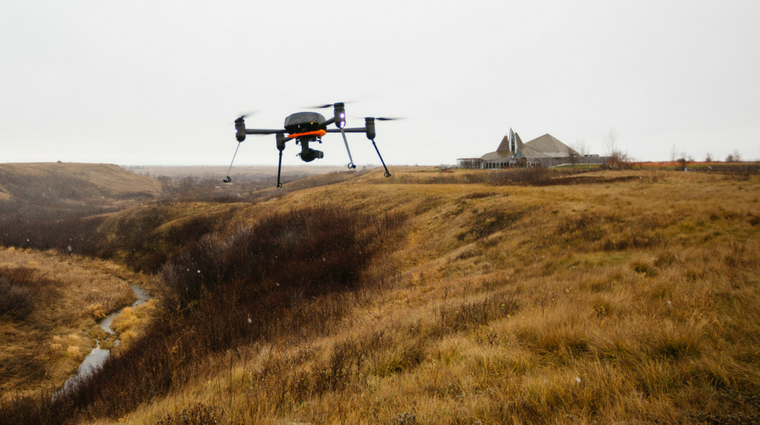
Applied Research used unmanned aerial vehicle (UAV) technology to assist with the capture and prosecution of the illegal moose poacher
April 13, 2018 – In April 2017, Draganfly Innovations and Saskatchewan Polytechnic received an Engage Grant from the Natural Sciences and Engineering Research Council of Canada (NSERC) to pursue research using UAVs to get a 3D snapshot of a conservation crime scene. In the same month, the partnership was able to put their project to the test, assisting with a wildlife investigation where a cow and calf moose were shot illegally near Alvena, SK.
Draganfly sells aerial solutions to law enforcement agencies around the world. Working closely with conservation officers, Sask Polytech researchers David Halstead and Leila Benmerrouche, and Draganfly sales lead Andrew Carson, were happy to put their applied research project to use in a real-world setting.
“Our systems provide ease of use and automated data collection, allowing law enforcement officers to easily collect information and recreate those scenes, essentially preserving their crime scene so it can be measured and observed,” Carson explains. “When developing a UAV program, it’s not just taking a drone out and flying it, but understanding the optimal work flow and sharing that with other officers.”
The applied research team used a fixed wing Sensefly eBee UAV to conduct a mapping mission of the area. A total of 150 photographs were taken by the UAV and used to recreate a 3D snapshot of the crime scene. A digitized tool was used to highlight tire and moose tracks. A nearly continuous set of tracks could be traced from where the moose was processed to where the vehicle had become stuck in the ditch.
“Conservation and environmental protection officers work in wide open spaces, where evidence of movements and actions of perpetrators such as wildlife poachers must be interpreted in complex terrain, unlimited by walls, streets or buildings,” says Halstead, a senior researcher and project manager within the School of Natural Resources and Built Environment in Prince Albert.
This was one of the first instances in Canada where a UAV has been used in the successful prosecution of a conservation related crime. The ability to tie the case together visually through the use of UAV technology was very beneficial in solidifying evidence and gave a visual story to what happened to the cow moose and calf.
Draganfly Innovations creates quality, cutting-edge unmanned vehicle systems and software that revolutionize the way people do business. Recognized as being at the forefront of technology for over 20 years, Draganfly is an award-winning, industry-leading manufacturer within the commercial UAV space, serving the public safety, agriculture, industrial inspections, and mapping and surveying markets. Draganfly is a company driven by passion, ingenuity, and the need to provide efficient solutions and first-class services to its customers around the world with the goal of saving time, money, and lives.
Saskatchewan Polytechnic serves 28,000 distinct students through applied learning opportunities at campuses in Moose Jaw, Prince Albert, Regina and Saskatoon, and through extensive distance education opportunities. Programs serve every economic and public service sector. As a polytechnic, the organization provides the depth of learning appropriate to employer and student needs, including certificate, diploma and degree programs, and apprenticeship training. Saskatchewan Polytechnic engages in applied research, drawing on faculty expertise to support innovation by employers, and providing students the opportunity to develop critical thinking skills.

